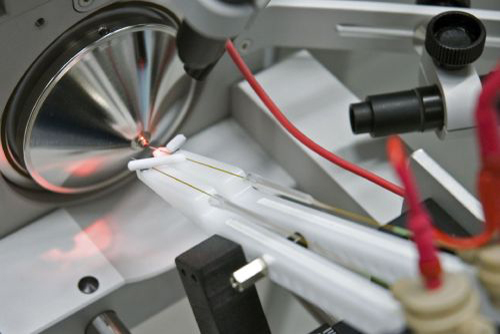Researchers observe thousands of protein switches

Ionization of the sample with electrospray prior to the mass spectrometer measurement. Copyright: MPI of Biochemistry
Using this technology, they revealed that the binding of the hormone insulin to the cell surface affects more than 1,000 proteins. These methods, which rely on mass spectrometry, enable the identification of the regulation of each of these proteins, and simplifies the simultaneous analysis of many samples in parallel. Therefore, EasyPhos is a breakthrough in deciphering the complex processes of healthy and diseased cells.
When insulin binds to the surface of a cell, a vast number of processes are activated. These allow the cell to respond to changing nutrient status, for example to absorb glucose after a meal. To enact these processes many different proteins are needed, which act like small machines within the cell. Their activity modulated by ‘phosphorylation’ – whereby a small phosphate molecule is added to the proteins at specific sites acting like a switch.
Researchers in the laboratory of Matthias Mann developed a method, which they called “EasyPhos” that allows them to identify the phosphorylation of proteins on a large scale within many cell or tissue samples.
Through mass spectrometric analysis, which identifies proteins by their masses, nearly all proteins can be characterized, even the activation of unknown ones. Their study shows that binding of insulin at the surface of mouse liver cells leads to activity changes in the phosphorylation of more than 1,000 of the 12,000 proteins existing in every cell.
“In this study, we used this technology to analyze phosphorylation in a time course, capturing the dynamics of insulin signaling,” says Sean Humphrey, the lead researcher of the study. Using EasyPhos, only small amounts of sample are needed, and the procedure is optimized for the measurement of many different cells or tissue samples.
This opens up the technology to a larger number of biological applications. With every measurement, the researchers obtain a huge amount of data. They therefore work closely with computational scientists at the MPI of Biochemistry who develop specific software to assist with data analysis.
Matthias Mann points out that the analysis of the proteome is of great importance. While genomic researchers analyze the DNA, which is the blueprint of the proteins, proteomics researchers directly observe these proteins at work.
This technology enables the analysis and understanding of the complex and dynamic processes within the cells, revealing important insights into these processes. In the future, EasyPhos will enable the comparison of activation patterns in diseased cells with those of healthy cells or tissues, and will therefore help to uncover the malfunction and causes of complex diseases.
[CM]
Original publication:
S.J. Humphrey, S.B. Azimifar, M. Mann: High-throughput phosphoproteomics reveals in vivo insulin signaling dynamics. Nature Biotechnology, September, 2015
DOI: 10.1038/nbt.3327
www.nature.com/nbt/journal/vaop/ncurrent/full/nbt.3327.html
Contact:
Prof. Dr. Matthias Mann
Proteomics and Signal Transduction
Max Planck Institute of Biochemistry
Am Klopferspitz 18
82152 Martinsried
Germany
E-Mail: mmann@biochem.mpg.de
http://www.biochem.mpg.de/mann
Anja Konschak
Public Relations
Max Planck Institute of Biochemistry
Am Klopferspitz 18
82152 Martinsried
Germany
Tel. +49 89 8578-2824
E-Mail: pr@biochem.mpg.de
http://www.biochem.mpg.de
http://www.biochem.mpg.de/en/news – More press releases of the MPI of Biochemistry
http://www.biochem.mpg.de/mann – Website of the Research Department “Proteomics and Signal Transduction” (Matthias Mann)
Media Contact
All latest news from the category: Life Sciences and Chemistry
Articles and reports from the Life Sciences and chemistry area deal with applied and basic research into modern biology, chemistry and human medicine.
Valuable information can be found on a range of life sciences fields including bacteriology, biochemistry, bionics, bioinformatics, biophysics, biotechnology, genetics, geobotany, human biology, marine biology, microbiology, molecular biology, cellular biology, zoology, bioinorganic chemistry, microchemistry and environmental chemistry.
Newest articles

High-energy-density aqueous battery based on halogen multi-electron transfer
Traditional non-aqueous lithium-ion batteries have a high energy density, but their safety is compromised due to the flammable organic electrolytes they utilize. Aqueous batteries use water as the solvent for…

First-ever combined heart pump and pig kidney transplant
…gives new hope to patient with terminal illness. Surgeons at NYU Langone Health performed the first-ever combined mechanical heart pump and gene-edited pig kidney transplant surgery in a 54-year-old woman…

Biophysics: Testing how well biomarkers work
LMU researchers have developed a method to determine how reliably target proteins can be labeled using super-resolution fluorescence microscopy. Modern microscopy techniques make it possible to examine the inner workings…





















